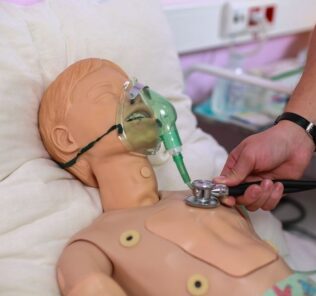How to Develop a Shared Mental Model in Healthcare Simulation
The development of a shared mental model is essential in all healthcare environments and can be practiced in clinical simulation. Every healthcare professional wants to be part of an effective team that can improve patient safety. Patient safety is everyone’s responsibility. When each person on the team practices TeamSTEPPS through situation monitoring and cultivates situation awareness through communication tools, the team can arrive at a shared mental model where everyone has a common perception of the situation and what to expect next. This HealthySimulation.com article explores ways to incorporate strategies to develop a shared mental model for clinical simulation teams.
TeamSTEPPS
Situation Monitoring is a process used to scan and assess an environment to determine the situation and how the performance of the team. Situation monitoring ensures that new or changing information is identified for communication and decision-making. Effective communication leads to efficacious support of each team member. Situation monitoring is a continuous process.
Sponsored Content:
The continuous process starts with situation monitoring is an individual skill that leads to situation awareness; an individual outcome which can lead to a shared mental model that is a team outcome. Situation monitor encompasses the components of STEP which stands for the status of the patient, team members, environment, and progress towards goal. Another tool for situation monitoring is the I’M SAFE Checklist. This tool reminds the team members to understand the illness, medication ordered/taken/withheld, stress, alcohol and drugs, fatigue, along with eating and elimination.
Situational awareness is the state of knowing the current conditions that affect one’s work including STEP, mentioned earlier. To enhance the situation awareness the team must use effective communication. TeamSTEPPS has identified several communication tools to promote a shared mental model.
Communication tools that promote effective communication and can be incorporated into healthcare simulation are SBAR, call-outs, check-backs, and handoffs. A simulation developer and facilitator must remember to use these evidence-based tools to prepare safe practitioners and to improve patient care and outcomes.
A shared mental model is the perception of understanding of, or knowledge about a situation or process that is shared among team members through communication. For the team to work effectively in patient care, the shared mental model guides the team to provide quality, safe care. The question often asked is how can one measure a shared mental model.
Sponsored Content:
Measure Shared Mental Model
There are several tools and strategies for evaluating a team for the presence of a shared mental model. A key factor in some research is the development and identification of a valid and reliable measure that assesses the perceptions of the shared mental model that is applicable to a wide range of tasks, teams, and organizational contexts. A general shared mental model scale could provide a solid anchor for a systematic, consistent, and methodical way to measure shared mental model across a wide range of environments. Researchers have developed a valid and reliable measure in the Five Factor Perceived Shared Mental Model (van Rensburg et al., 2022).
Five Factor Perceived Shared Mental Model
van Rensburg and colleagues (2022) identified five key factors to measure and understand the perception of a shared mental model. These factors also have concepts to expand upon each factor. In each factor, the team must have a shared understanding among the team about:
- Equipment includes the equipment, tools, and technology used to perform tasks of the team
- Execution focuses on the duties, work processes, and procedures relevant in performance of team tasks
- Interaction examines the most appropriate ways and means that team members interact and communicate with each other
- Composition identifies the members’ knowledge, skills, and abilities
- Temporal is related to the time and other temporal aspects related to their environment
Conditions that Impact Situation Awareness and Shared Mental Model
Conditions that impact situation awareness which impacts SMM are failure to share information with the team, request information from others, direct information to specific team members, include patient or family in communication, utilize resources fully, maintain documentation, know and understand where to focus attention, know and understand the plan, and inform team members the plan has changed.
How Shared Mental Models Help Teams
A shared mental model provides a road map for the team to know where they are headed and when they arrive at the outcome and goal. Strategies have been identified to promote team effectiveness through a shared mental model. The tools and best practices assist to promote better teams. Through use of these practices, the team can develop a mutual understanding of the situation, which can lead to more effective communication. When the team communicates appropriately the members understand each role of the and how they are intertwined. This allows the team to predict the anticipated needs to create a similar purpose to achieve the ultimate goal to improve healthcare outcomes.
Watch the HealthySimulation.com LEARN CE/CME Platform webinar on Building Better Clinical Simulation Experiences Through Collaborative Cross Staff Training
Key Factors to Incorporate Shared Mental Model Development in Simulation Scenarios
The major concepts and factors to incorporate into a clinical simulation program and scenarios have been discussed in the article. As the simulation designer or developer, incorporate phases in the scenario to practice effective communication. TeamSTEPPS has several tools that can be implemented in healthcare simulation that can be translated into safe, quality clinical practice. Remember, the rationale for clinical simulation is to allow participants to learn best practices without harm to a patient to promote clinical judgment and critical thinking ability.
Learn more about Shared Mental Models from the American Hospital Association and TeamSTEPPS from the AHRQ.
References
- Gisick, L. M., Webster, K. L., Keebler, J. R., Lazzara, E. H., Fouquet, S., Fletcher, K., Fagerlund, A., Lew, V., & Chan, R. (2018). Measuring shared mental models in healthcare. Journal of Patient Safety and Risk Management, 23(5), 207-219. https://journals.sagepub.com/doi/10.1177/2516043518796442
- van Rensburg, J. J., Santos, C. M., de Jong, S. B., & Uitdewilligen, S. (2022). The five-factor perceived shared mental model scale: A consolidation of items across the contemporary literature. Frontiers in psychology, 12, 784200. https://doi.org/10.3389/fpsyg.2021.784200
Teresa Gore, PhD, DNP, APRN, FNP-BC, CHSE-A, FSSH, FAAN – Dr. Gore has experience in educating future nurses in the undergraduate and graduate nursing programs. Dr. Gore has a PhD in Adult Education, a DNP as a family nurse practitioner, and a certificate in Simulation Education. Dr. Gore is an innovative, compassionate educator and an expert in the field of healthcare simulation. In 2007l Teresa started her journey in healthcare simulation. She is involved in INACSL and SSH. She is a Past-President of INACSL and is a Certified Healthcare Simulation Educator Advanced (CHSE-A). In 2018, she was inducted as a Fellow in the American Academy of Nursing (FAAN). In 2021, she was inducted as a Fellow in the Society of Simulation in Healthcare Academy (FSSH) and selected as a Visionary Leader University of Alabama at Birmingham School of Nursing Alumni. During her career, Dr. Gore has led in the development and integration of simulation into all undergraduate clinical courses and started an OSCE program for APRN students. Her research interests and scholarly work focus on simulation, online course development and faculty development. She has numerous invited presentations nationally and internationally on simulation topics.
Sponsored Content:





















